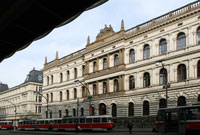An Article by Czech Scientists in the Journal of Wildlife Diseases
Scientists from Moravian workplaces have proved that bats here suffer from white-nose syndrome, a fungal disease that is threatening the ecosystem in North America. In the Czech Republic as well as in other parts of Europe, bats with this syndrome die only very rarely and the disease has not yet caused a decline in the population numbers. Uncovering the cause of ‘European immunity’ could save North American bats and avert also the disruption of the biological balance in that part of the world.
New knowledge of the pathology of bats infected with the white-nose syndrome fungus in Europe
was published this January by an international team of researchers in the Journal of Wildlife
Diseases (see
http://www.jwildlifedis.org/content/48/1/207.abstract)
‒ a prestigious international journal, which publishes results of original research on diseases,
environmental contaminations and other factors influencing the health of wild animals. ‘For several
years, we have known that the Geomyces destructans fungus, which causes white-nose syndrome in
North America, is present in Europe, but only now have we been able to diagnose also the disease
itself in European bats,’ says co-author of the article Mgr. Natália Martínková, Ph.D., from the
Institute of Vertebrate Biology of the Academy of Sciences and the Institute of Biostatistics and
Analyses of Masaryk University in Brno. The team also found dead greater mouse-eared bats (Myotis
myotis) with an early stage of white-nose syndrome in the Moravian Karst. However, the annual
monitoring of the bat populations, conducted by the Czech Bat Conservation Trust, has not shown any
significant reduction of the number of these flying mammals.
In North America, white-nose syndrome first appeared in 2006 in the northeast of the USA.
Since that time, it has spread to other areas, where several affected species of bats have died en
masse. In Europe, the first positive finding of Geomyces destructans was recorded in Germany in
2008, but according to historical photographs, bats with fungal growth seem to have already
appeared sporadically decades ago. Yet, even three years after the fungus was first detected in
Europe, no massive mortality of bats at hibernation sites nor an increased death rate elsewhere has
been observed. This difference in survival has been attributed to bats having adapted to the
infection in Europe and white-nose syndrome not developing among them.
Pathological investigations, conducted by prof. MVDr. Jiří Pikula, Ph.D., along with his
co-workers from the Veterinary and Pharmaceutical University in Brno, proved that bats in Europe
have the same changes on the skin that are used to diagnose white-nose syndrome in North America.
The fungus grows through the layers of epidermis and it forms dense clusters of spores on the
surface of the skin.
‘Our task now is to determine why bats in Europe survive with white-nose syndrome better than
bats in North America. Such information could help to design management practices to resolve the
ecological catastrophe in North America,’ explains Natália Martínková.
For more detailed information, contact: Mgr. Natália Martínková, Ph.D., Institute of
Vertebrate Biology of the ASCR in Brno, mobile: +420 606 124 586, email:
martinkova@ivb.cz
Prepared by: The Department of Media Communication of the Head Office of the ASCR and the
Institute of Vertebrate Biology of the ASCR

The Geomyces destructans fungus, which causes the White Nose Syndrome
Photo: Natália Martínková

A large bat (Myotis myotis) often overwinters in groups. The animals thus save energy, but at
the same time a fungus can spread among them. The bat on the left has a growth of a fungus on the
nose and wings, but the other individuals in the group only on the tail membrane and the back legs.
Photo: Stanislav Martínek

A large bat (Myotis myotis) with a growth of the Geomyces destructans fungus around the snout
Photo: Stanislav Martínek


A healthy large bat (Myotis myotis)
Photo: Natália Martínková
20 Jan 2012









